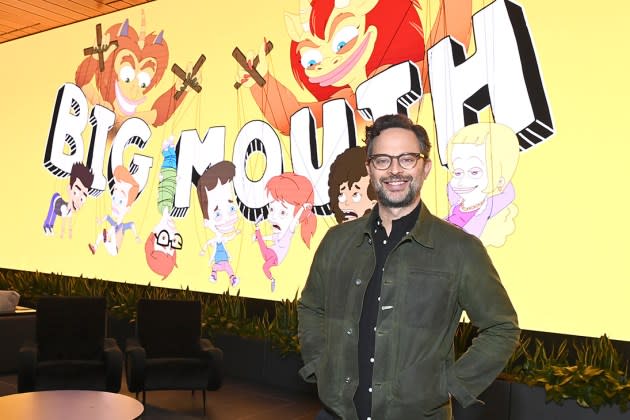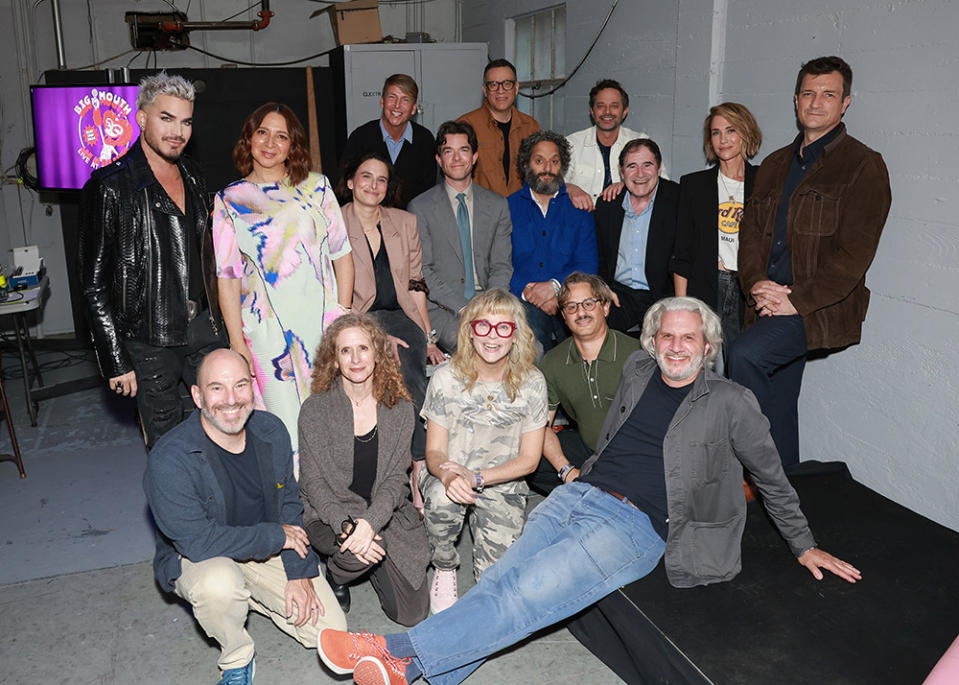‘Big Mouth’ Star Nick Kroll Voices 79 Characters in Netflix’s Longest-Running Show. Where’s His Emmy?

Nick Kroll deserves an Emmy. If not for his contribution to the whip-smart writing and flat-out boldness of his long-running, raunchy yet tender, semi-autobiographical Netflix series, Big Mouth, then perhaps there’s a more compelling argument. The actor has been seen on some of the better small-screen comedy programs over the past 15 years and should win the medium’s top prize on sheer volume, as he voices a staggering 79 characters on the beloved adult animation series, which is set to conclude after eight seasons next year.
But don’t ask Kroll to name all 79 character voices he’s created for the show. In fact, speaking with The Hollywood Reporter, he explained how Netflix had to do some quick research and fact-check that figure ahead of this year’s Emmy voting, which started this week, now that he is throwing his hat in the ring for the outstanding character voice-over performance award.
More from The Hollywood Reporter
Not that Big Mouth, which has the distinction as Netflix’s longest-running show for adults, gets shut out on Emmy night. It’s seen multiple best animated series nominations, one of its many musical numbers got a nod, and Kroll’s castmate Maya Rudolph has already taken the Emmy for outstanding character voice-over performance three times for her instant-classic work as Connie, the hormone monstress. Where Rudolph can make a simple phrase like “bubble bath” have audiences cackling and remix videos of Connie uttering those words go viral, Kroll is very much the show’s soul. That’s because one of the 79 characters he voices is Big Mouth’s central character, Nick, a fickle, doted-upon pubescent avatar of Kroll himself as a preteen whose flaws are never coated and vulnerabilities are often laid bare.
Yet for every main or recurring character Kroll portrays in the ensemble — Maury the hormone monster, Lola Ugfuglio Skumpy and Coach Steve, just to name a few — he’ll do roughly 10 ephemeral, one-off characters. These include the streetwise ladybug whose personal history is quite the rich tapestry and the world-weary Statue of Liberty (with a French accent, naturally).
“When you create a show, it’s always like, ‘Alright, can you just pop to and do, you know, do a… surfing tampon?’ And you’re like, ‘Yeah…I can do that,’” he explains. “So there’s this massive amount of voices that I’ve popped in to do, and then there’s the main cast voices that I do, which proportionally is very high for the show.”

But is there a character that he voices that holds a favorite status? Kroll has to run with the fans when asked and goes with Lola, the middle school girl-bully whose lonely home life and bold attitude resonate with many vocal fans. “That’s been a pleasure,” he says. “Because she started as this sad kind of outcast girl that I and the writers were always really excited about. And she just took a while to then, I think, become much more central to the show.”
Lola, so confident by season seven that she’s become an insurance liability, has kept pace in her evolution along with all the characters Kroll and his lifelong friend, Andrew Goldberg, created with Mark Levin and Jennifer Flackett. While change is naturally the central theme to this series about puberty, the horrors of middle school and the evolving nature of adolescent friendships, Kroll caveats that even though it sounds cheesy, he believes it’s essential they “let the characters tell you who they want to become and who they are.”
“Unlike basically any other animated show, our kids grow up and change, and we change everything about them — their character designs have changed, what they’re wearing, their height. We’ve slowly morphed certain characters because we want to mark this,” he says, adding, “The beauty of telling stories about kids who are evolving is that it never gets tired, and you’re always finding new elements, new stories to tell and new emotions for those kids … because the show itself does not stand still, it makes it more gratifying to perform.”
The arc of the characters over Big Mouth’s nearly 100 episodes had a strong assist Kroll says, from a partnership with Bay Area health educator Shafia Zaloom, who has invited her class at the Urban School in San Francisco to dialogue with Big Mouth’s writers about what is resonating and where the show is lacking. On her website, Zaloom writes that as an educator, she seeks to “discuss the complexities of teen culture and decision-making with straight-forward, open and honest dialogue.”
“Every season, we have long conversations and try to understand emotionally what these kids are going through psychologically and scientifically,” says Kroll. “But also talk to kids and be like, ‘’Here’s what’s happening to our schools. Here’s what’s happening with kids right now. Here’s what didn’t feel true to us about last season.”
This approach is one part that has brought some honest, fearless storytelling from the Big Mouth writers room on topics that might seem counterintuitive for animated entertainment. For example, the season two episode centered on debunking falsehoods about Planned Parenthood or the decision to demystify adolescent shame via a 360-degree character study of David Thewlis’ Shame Wizard villain. As the show’s end approaches, feelings of immense pride have emerged from what appears to have initially been an abrupt end for the team behind the show.
“When you see season eight… We’re very happy with how we’ve finished the show. It was incredibly new when we were writing it that it was the last season. And I’m really excited for people to see it when it comes out,” Kroll says, adding that he and Netflix agree it feels like a good time to step away from these characters. “But I love them, and I’m so curious to see where they land.”
It’s also my story,” he concludes. “It’s an incredibly personal story. It’s based on my life. I’ve been so invested in their lives for so many reasons. And I love these kids, and I love the monsters, and I love the parents. We ended it, and the door is open to come back and visit these kids down the line.”
Best of The Hollywood Reporter

 Yahoo News
Yahoo News 